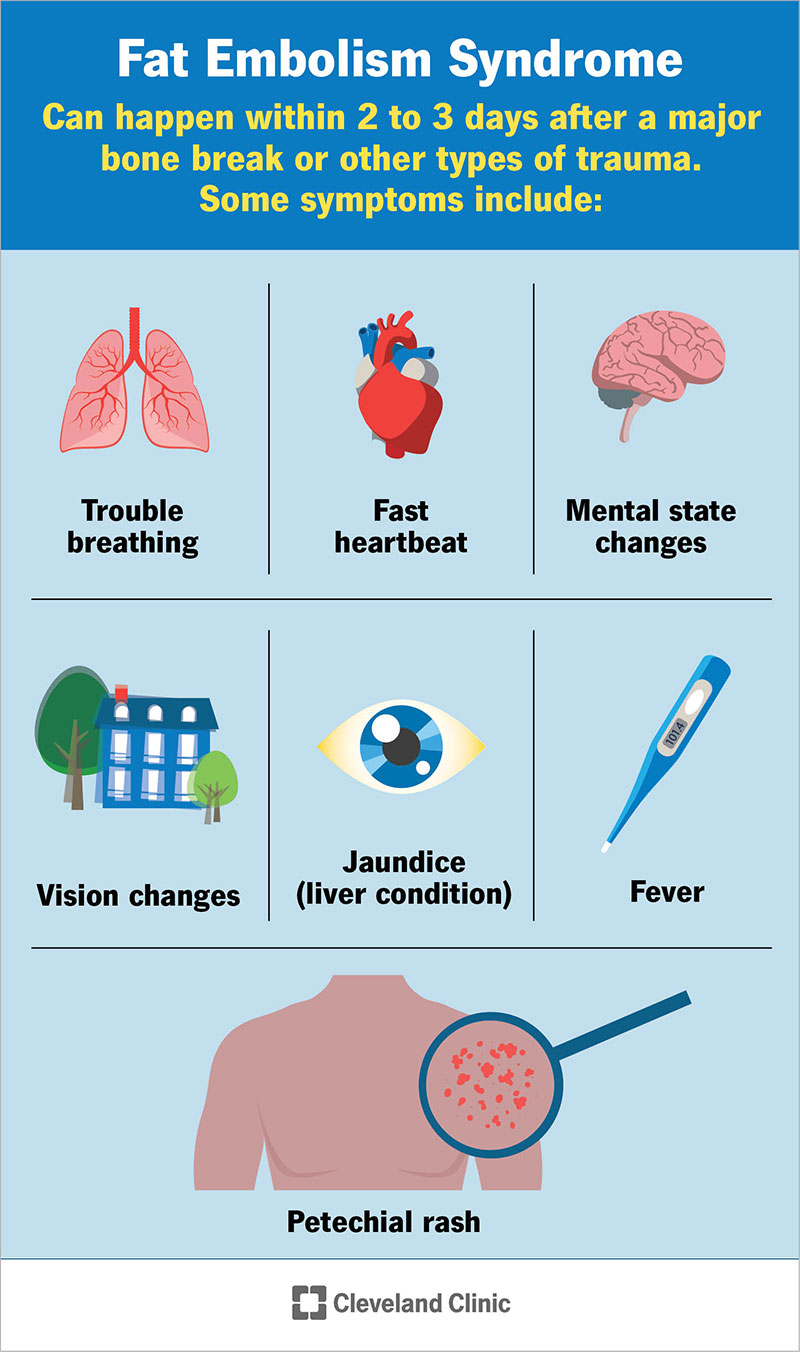Fat Embolism

Fat Embolism and Fat Embolism Syndrome (FES): Causes, Symptoms, Diagnosis, and Management
Definition and Mechanism
A fat embolism occurs when fat droplets enter the bloodstream and lodge in small blood vessels, obstructing blood flow. When this leads to a constellation of clinical symptoms, it is termed fat embolism syndrome (FES). FES is most commonly seen after trauma—particularly long bone (femur, tibia) or pelvic fractures—or orthopedic surgery, but can also occur in non-traumatic conditions such as pancreatitis, fatty liver disease, bone marrow transplant, and liposuction246.
The underlying mechanism involves both the physical obstruction of vessels by fat globules and a systemic inflammatory response, which together cause multi-organ dysfunction46.
Symptoms and Clinical Features
Symptoms usually develop within 12–72 hours after the inciting event56. The classic triad includes:
- Respiratory distress: Shortness of breath, rapid breathing, low oxygen levels, and in severe cases, acute respiratory failure or ARDS1256.
- Neurological symptoms: Confusion, drowsiness, agitation, seizures, or coma. Mental status changes are common and may occur in the absence of head injury156.
- Petechial rash: Small red or purple spots, typically on the chest, neck, upper arms, buccal mucosa, and conjunctivae. This occurs in about 50% of cases and is transient156.
Other signs may include fever, rapid heart rate, decreased urine output, and in severe cases, multi-organ failure256.
Causes and Risk Factors
- Traumatic: Long bone or pelvic fractures (most common), orthopedic surgeries (especially joint replacements), severe soft tissue injuries, burns, and crush injuries246.
- Non-traumatic: Pancreatitis, fatty liver disease, bone marrow transplant, sickle cell anemia, and liposuction246.
Diagnosis
There is no single definitive test for FES, making diagnosis clinical, based on history and symptoms145. Diagnostic criteria (e.g., Gurd’s criteria) rely on major features (respiratory symptoms, cerebral involvement, petechial rash) and minor features (fever, tachycardia, retinal changes, anemia, thrombocytopenia, renal abnormalities)5.
- Imaging: Chest X-rays may show diffuse infiltrates; CT scans can reveal lung blockages; MRI may show small brain infarcts25.
- Laboratory: Blood gases (hypoxemia), anemia, thrombocytopenia, high ESR, and sometimes fat globules in blood, urine, or sputum56.
Management
No specific cure exists; treatment is supportive:
- Oxygen therapy and, if needed, mechanical ventilation for respiratory failure126.
- IV fluids to maintain blood pressure and organ perfusion6.
- Corticosteroids may be considered, though evidence is mixed2.
- Early stabilization of fractures reduces risk of FES4.
- Monitoring and supportive care for neurological and renal complications126.
Complications and Prognosis
- Severe cases can lead to acute respiratory distress syndrome (ARDS), prolonged coma, organ failure, and death (mortality ~10%)26.
- Most patients recover fully with prompt recognition and supportive care, but severe cases may have lasting neurological or pulmonary deficits12.
Prevention
- Early immobilization and surgical fixation of fractures4.
- Careful surgical technique to minimize fat release during orthopedic procedures2.
- Close monitoring of high-risk patients after trauma or surgery2.
Summary Table
| Aspect | Details |
|---|---|
| Definition | Fat droplets in bloodstream causing vessel blockage and systemic symptoms (FES) |
| Main Causes | Long bone/pelvic fractures, orthopedic surgery, trauma, pancreatitis, fatty liver, etc. |
| Key Symptoms | Respiratory distress, neurological changes, petechial rash |
| Diagnosis | Clinical criteria, imaging, blood tests; no single definitive test |
| Treatment | Supportive care: oxygen, fluids, ventilation, early fracture fixation |
| Complications | ARDS, organ failure, death (10% risk), possible long-term deficits |
| Prevention | Early fracture stabilization, careful surgical technique, close monitoring |
Consult with Our Team of Experts Now!
At DrStemCellsThailand (DRSCT)‘s Anti-Aging and Regenerative Medicine Center of Thailand, we emphasize comprehensive evaluations and personalized treatment plans of Cellular Therapy and Stem Cells for managing various health conditions. If you have questions about Fat Embolism or would like more information on our services, consult with our experts today!
Consult with Our Team of Experts Now!
References:
1 Cleveland Clinic
2 Infiniskin
3 PMC6543189
4 PMC3665122
5 Patient.info
6 Wikipedia
Fat embolism syndrome is a rare but potentially life-threatening complication of trauma and certain medical conditions. Rapid recognition and supportive management are key to improving outcomes.















